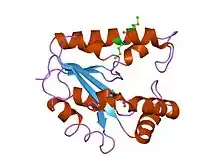| Chloramphenicol phosphotransferase-like protein | |||||||||
|---|---|---|---|---|---|---|---|---|---|
 crystal structure of atu3015, a putative cytidylate kinase from agrobacterium tumefaciens, northeast structural genomics target atr62 | |||||||||
| Identifiers | |||||||||
| Symbol | CPT | ||||||||
| Pfam | PF07931 | ||||||||
| Pfam clan | CL0023 | ||||||||
| InterPro | IPR012853 | ||||||||
| SCOP2 | 1grq / SCOPe / SUPFAM | ||||||||
| CDD | cd00227 | ||||||||
| |||||||||
In molecular biology, the chloramphenicol phosphotransferase-like protein family includes the chloramphenicol 3-O phosphotransferase (CPT) expressed by Streptomyces venezuelae. Chloramphenicol (Cm) is a metabolite produced by this bacterium that can inhibit ribosomal peptidyl transferase activity and therefore protein production. By transferring a phosphate group to the C-3 hydroxyl group of Cm, CPT inactivates this potentially lethal metabolite.[1][2]
References
- ↑ Izard T (August 2001). "Structural basis for chloramphenicol tolerance in Streptomyces venezuelae by chloramphenicol phosphotransferase activity". Protein Science. 10 (8): 1508–13. doi:10.1002/pro.101508. PMC 2374082. PMID 11468347.
- ↑ Izard T, Ellis J (June 2000). "The crystal structures of chloramphenicol phosphotransferase reveal a novel inactivation mechanism". The EMBO Journal. 19 (11): 2690–700. doi:10.1093/emboj/19.11.2690. PMC 212772. PMID 10835366.
This article is issued from Wikipedia. The text is licensed under Creative Commons - Attribution - Sharealike. Additional terms may apply for the media files.